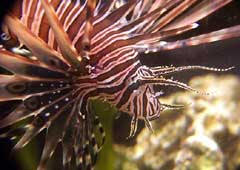Adaptation
Coloration
The devil firefish is extremely well adapted to its coral reef environment. The most obvious adaptation is its colorful array of brown, maroon and white stripes that cover its body. Most fish have a more modest coloration that consists of shades of grey or tan to blend in with many ocean habitats, so they do not draw attention from predators. Its vibrant colors and stripes help it blend into its coral environment. Even when spotted, its coloration sends a warning shot to predators to stay away because it is venomous. Most predators are intimidated and wisely choose to pursue an easier, less painful meal.
Photo taken from NOAA.gov
Scales
Scales are another important adaptation for the firefish. Its scales are referred to as cycloid scales. Cycloid scales are very thin and overlap each other. These scales allow for increased flexibility. This is an important adaptation for a fish that lives inbetween rocks and corals. This allows the firefish to navigate into hard to reach places to avoid predators or even catch prey.

Photo taken from NOAA.gov
Venomous Spines
Another obvious adaptation is its long fins and spines. When approached by a predator, it spreads its fins out to show off its coloration and appear too big to eat. This is very successful, since it has very few known predators. The drawback to having such big fins is that the lionfish is very slow moving. Since it is slow, it relies heavily on its venomous fins and spikes to deter predators from trying to eat them. The spines contain venom glands that produce acetylcholine.
Taken from NOAA.gov Photo credit: Stephen Nives
Venom
Acetylcholine is a strong neurotransmitter toxin that is used by the
devil firefish to defend itself from predators. When
acetylcholine enters the blood stream, it paralyzes skeletal muscles in
fish that causes extreme pain, paralysis, and will cause the fish to die
within minutes. In humans, being stung will be extremely painful for
several days, causing extreme sweating, distress, and in extreme cases, paralysis.
The chemical formula for acetylcholine is C7NH16O+
2.
These are all some of the adaptations that are unique to the devil firefish, which help it become better adapted to its environment. Its adaptations led it to inhabit a vast amount of coastline in its native Indo-Pacific region and in its non-native Caribbean Atlantic region. Its success is being felt by the entire invaded ecosystem, as it has no natural predators and a voracious appetite for fish and crustaceans, which play a key role as a food source for many other organisms.
See how and which organisms are being directly affected by the devil firefish’s diet by clicking on the Nutrition page.


